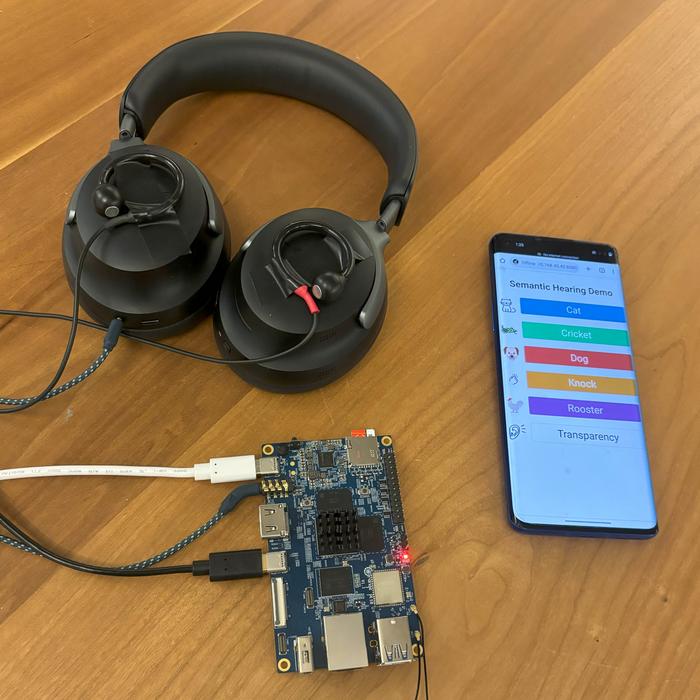OTTAWA, Ontario, May 16, 2024 – Noise-canceling headphones are a godsend for living and working in loud environments. They automatically identify background sounds and cancel them out for much-needed peace and quiet. However, typical noise-canceling fails to distinguish between unwanted background sounds and crucial information, leaving headphone users unaware of their surroundings.

Credit: Shyam Gollakota
OTTAWA, Ontario, May 16, 2024 – Noise-canceling headphones are a godsend for living and working in loud environments. They automatically identify background sounds and cancel them out for much-needed peace and quiet. However, typical noise-canceling fails to distinguish between unwanted background sounds and crucial information, leaving headphone users unaware of their surroundings.
Shyam Gollakota, from the University of Washington, is an expert in using AI tools for real-time audio processing. His team created a system for targeted speech hearing in noisy environments and developed AI-based headphones that selectively filter out specific sounds while preserving others. He will present his work Thursday, May 16, at 1:20 p.m. EDT as part of a joint meeting of the Acoustical Society of America and the Canadian Acoustical Association, running May 13-17 at the Shaw Centre located in downtown Ottawa, Ontario, Canada.
“Imagine you are in a park, admiring the sounds of chirping birds, but then you have the loud chatter of a nearby group of people who just can’t stop talking,” said Gollakota. “Now imagine if your headphones could grant you the ability to focus on the sounds of the birds while the rest of the noise just goes away. That is exactly what we set out to achieve with our system.”
Gollakota and his team combined noise-canceling technology with a smartphone-based neural network trained to identify 20 different environmental sound categories. These include alarm clocks, crying babies, sirens, car horns, and birdsong. When a user selects one or more of these categories, the software identifies and plays those sounds through the headphones in real time while filtering out everything else.
Making this system work seamlessly was not an easy task, however.
“To achieve what we want, we first needed a high-level intelligence to identify all the different sounds in an environment,” said Gollakota. “Then, we needed to separate the target sounds from all the interfering noises. If this is not hard enough, whatever sounds we extracted needed to sync with the user’s visual senses, since they cannot be hearing someone two seconds too late. This means the neural network algorithms must process sounds in real time in under a hundredth of a second, which is what we achieved.”
The team employed this AI-powered approach to focus on human speech. Relying on similar content-aware techniques, their algorithm can identify a speaker and isolate their voice from ambient noise in real time for clearer conversations.
Gollakota is excited to be at the forefront of the next generation of audio devices.
“We have a very unique opportunity to create the future of intelligent hearables that can enhance human hearing capability and augment intelligence to make lives better,” said Gollakota.
###
———————– MORE MEETING INFORMATION ———————–
Main meeting website: https://acousticalsociety.org/ottawa/
Technical program: https://eppro02.ativ.me/src/EventPilot/php/express/web/planner.php?id=ASASPRING24
ASA PRESS ROOM
In the coming weeks, ASA’s Press Room will be updated with newsworthy stories and the press conference schedule at https://acoustics.org/asa-press-room/.
LAY LANGUAGE PAPERS
ASA will also share dozens of lay language papers about topics covered at the conference. Lay language papers are summaries (300-500 words) of presentations written by scientists for a general audience. They will be accompanied by photos, audio, and video. Learn more at https://acoustics.org/lay-language-papers/.
PRESS REGISTRATION
ASA will grant free registration to credentialed and professional freelance journalists. If you are a reporter and would like to attend the hybrid / in-person meeting or virtual press conferences, contact AIP Media Services at [email protected]. For urgent requests, AIP staff can also help with setting up interviews and obtaining images, sound clips, or background information.
ABOUT THE ACOUSTICAL SOCIETY OF AMERICA
The Acoustical Society of America is the premier international scientific society in acoustics devoted to the science and technology of sound. Its 7,000 members worldwide represent a broad spectrum of the study of acoustics. ASA publications include The Journal of the Acoustical Society of America (the world’s leading journal on acoustics), JASA Express Letters, Proceedings of Meetings on Acoustics, Acoustics Today magazine, books, and standards on acoustics. The society also holds two major scientific meetings each year. See https://acousticalsociety.org/.
ABOUT THE CANADIAN ACOUSTICAL ASSOCIATION/ASSOCIATION CANADIENNE D’ACOUSTIQUE
• fosters communication among people working in all areas of acoustics in Canada
• promotes the growth and practical application of knowledge in acoustics
• encourages education, research, protection of the environment, and employment in acoustics
• is an umbrella organization through which general issues in education, employment and research can be addressed at a national and multidisciplinary level
The CAA is a member society of the International Institute of Noise Control Engineering (I-INCE) and the International Commission for Acoustics (ICA) and is an affiliate society of the International Institute of Acoustics and Vibration (IIAV). Visit https://caa-aca.ca/.
###




